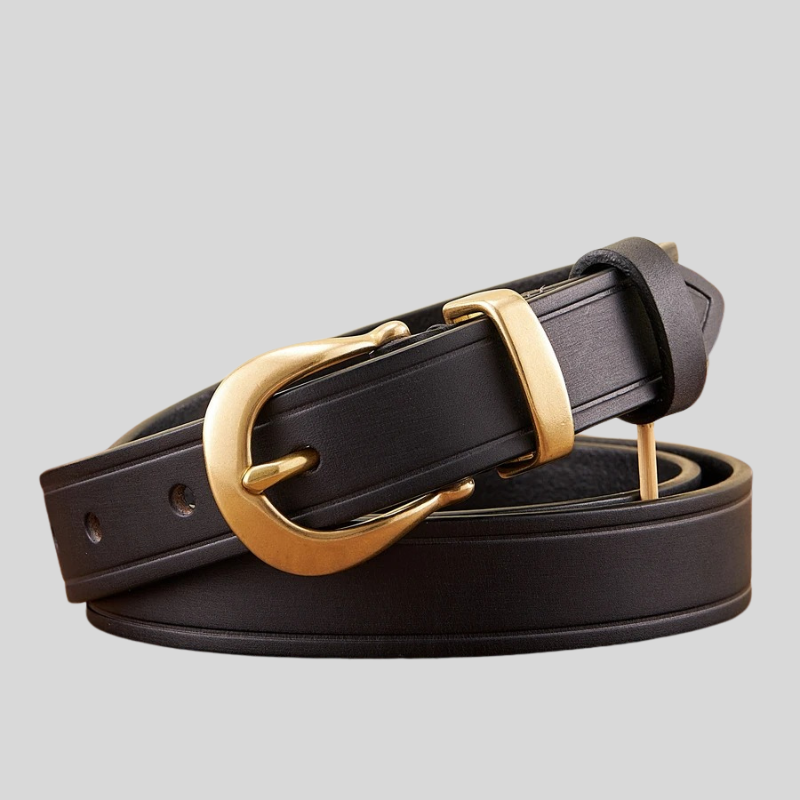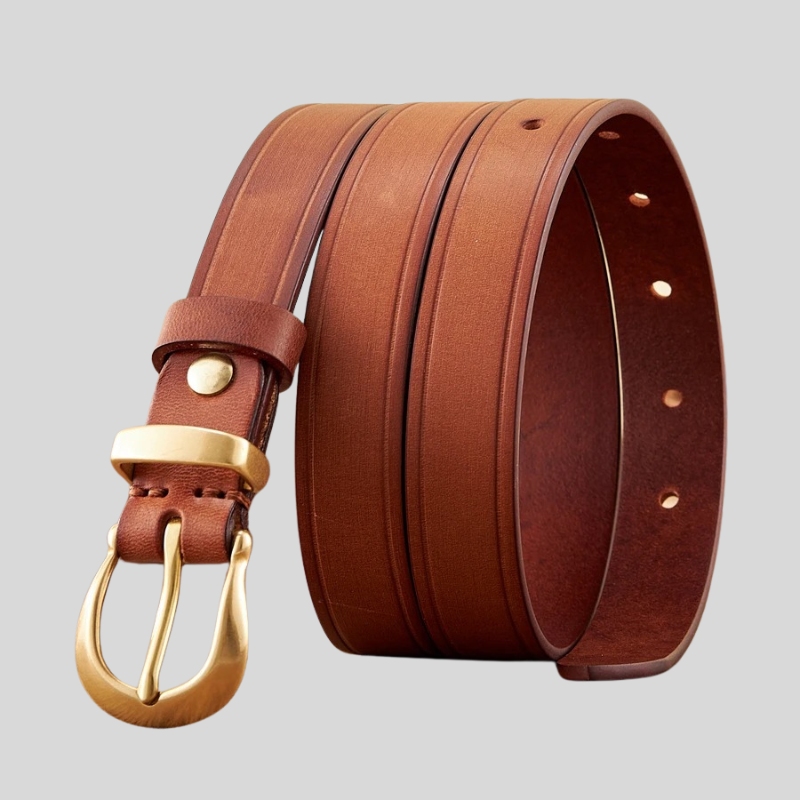Cowboy Cowhide Belt - Height 2.4cm
Cowboy Cowhide Belt - Height 2.4cm
Couldn't load pickup availability







-

Finishing and Quality Controls: Ensuring Excellence
Finishing and quality control are the last but crucial step in the production of high-quality leather belts. These final details ensure that each product is both aesthetically and functionally flawless, and meets the high standards required by the luxury market.
1. Edge finishing
One of the most important aspects of finishing is the processing of the edges of the belt. After cutting and assembly, the edges of the leather are sanded, dyed or treated to prevent fraying and give a uniform and clean appearance. This process not only improves the aesthetics, but also the durability of the belt, protecting it from wear and tear over time.
2. Surface care
The surface of the leather is further treated to remove any imperfections, creases or marks. In some cases, a protective finish is applied to protect the leather from moisture, scratches or signs of wear, ensuring that the belt retains its new appearance for years.
3. Functionality testing
Before the belt is released for sale, each individual unit is subjected to a functionality test. It is checked that the buckle engages correctly, that the holes are well aligned and that the belt can be put on without difficulty. The loops and stitching are also examined to ensure they are secure and well finished.
4. Aesthetic check
The aesthetic check is equally important: the consistency of the color, the regularity of the cut and the quality of the stitching are evaluated. Every detail, from the insertion of logos or decorations to the finishing of the buckle, must be perfect. Any minor defects are corrected or the entire belt is rejected.
5. Quality certification
Finally, the belt must pass rigorous quality standards established by the company. Only belts that meet all the criteria, from the choice of materials to the packaging, are approved for sale. This step ensures that the customer receives a product of excellence that reflects the true value of craftsmanship.
The finishes and quality controls are what distinguish a high-level artisan belt, offering the customer an accessory that is not only aesthetically pleasing, but also durable and functional for years.
The Leather Belt Manufacturing Process: Behind the Scenes
-

The Selection of Skins: The Quality Raw Material
The production of a high-quality leather belt begins with the selection of the raw material. The leather is the heart of every belt and determines not only the aesthetic appearance of the accessory, but also its resistance and durability. The best manufacturers choose leathers from controlled farms, ensuring that the material is free from defects, homogeneous and workable with precision.
Cowhides are among the most used thanks to their strength and ability to age beautifully, but other types of leather such as sheep or goat can also be used for lighter or more sophisticated models. Each type of leather has unique characteristics: some are softer and more flexible, others more rigid and resistant, and this variety allows designers to adapt the material choices to the style and function of the belt.
In addition to the type of leather, the tanning method also plays a fundamental role. Vegetable tanning, for example, offers a more natural and sustainable process, with leathers that acquire a unique patina over time. A well-selected leather guarantees not only an excellent finish, but also a final product that will be appreciated for its durability and beauty for many years.
-

Leather Cutting: Precision and Mastery
Once the leather has been selected, the next step in the belt production process is cutting, an operation that requires a combination of artisanal skill and technical precision. Cutting the leather is a crucial moment: a mistake at this stage could compromise the entire quality of the product. This is where the mastery of the craftsmen comes into play, who work the leather with great care to obtain perfectly regular and symmetrical pieces.
Using traditional tools such as the cutting knife or special machines for the most complex cuts, the craftsman follows patterns studied to the millimetre to avoid waste and make the most of the material. Each part of the leather has a slightly different texture, so carefully choosing where to cut is essential to maintain uniformity and consistency in the finished product.
Furthermore, cutting affects not only the aesthetic appearance, but also the functionality of the belt. Precisely cut leather prevents deformations over time and guarantees a perfect fit. Attention to detail at this stage is what distinguishes a high-quality artisanal belt from a mass-produced industrial product. The precision of the cut is, therefore, one of the key characteristics that ensures the durability and elegance of the final product.
-

Stitching and Finishing: Attention to Detail
Stitching and finishing are essential in the creation of high-quality leather belts. These details, often overlooked in mass-produced products, represent the artisanal soul of an accessory and determine its longevity and aesthetics. Each stitching requires precision, skill and a careful eye, as even the smallest error can compromise the integrity of the belt.
In artisanal belts, stitching is done by hand or with specialized machinery that allows for a uniform and resistant weave. The thread used is often made of high-quality material, such as waxed cotton or nylon, chosen to resist wear and maintain its solidity over time. In addition, the tension of the thread must be carefully balanced: too loose and the belt will fall apart, too tight and it risks deforming the leather.
Finishing is equally important. The edge of the belt is sanded and, in some cases, dyed or painted to give a more refined appearance and protect the leather from wear. The ends of the belt are often reinforced to ensure greater durability and prevent fraying. Even the buckles and metal details are carefully checked and harmoniously integrated into the design.
The attention to detail in the stitching and finishing not only gives the belt an elegant look, but also ensures that the accessory retains its beauty and functionality over time. These small but significant details are what distinguish a luxury handcrafted product from a simple mass-produced accessory. -

The Assembly: When Skin Takes Shape
Assembly is the stage where the leather, previously cut and finished, finally takes the shape of a belt. This process requires a combination of manual skills and specific techniques, as each component must be joined with precision to ensure functionality, resistance and aesthetics. Now let’s go through all the steps for assembly:
1. Preparing the main band
The process begins with the main band of the belt, which represents the base to which all the other components are added. The leather has already been cut and finished, ready to be worked.
2. Attaching the buckle
The buckle is one of the most important elements, both from a functional and aesthetic point of view. It is fixed with rivets or press studs, ensuring that it is stable but with the freedom of movement necessary to adjust the belt easily.
3. Making the holes
The holes for the buckle must be drilled with extreme precision to ensure that the belt can adapt perfectly to different sizes. The distance and alignment of the holes are essential for the comfort and functionality of the belt.
4. Inserting the belt loops
The small but essential belt loops are sewn or pinned to keep the belt close to the body, preventing the end from slipping away from the rest of the belt.
5. Adding decorative details
Any decorations, such as decorative stitching, engraved logos or metal inserts, are added at this stage, helping to give the belt a distinctive character and define its style.
6. Final inspection and finishing
After assembly, a quality control check is carried out to ensure that all components have been correctly attached and that the belt looks and functions perfectly.
Discover our selection of leather belts
-
Manly Cowhide Belt - Height 3.8cm
Regular price $49.00 USDRegular priceUnit price / per$69.00 USDSale price $49.00 USDSale -
Elegant Cowhide Belt - Height 3.8cm
Regular price $49.00 USDSale price $49.00 USDUnit price / perSale -
Retro Cowhide Belt - Height 3.8cm
Regular price $59.00 USDRegular priceUnit price / per$79.00 USDSale price $59.00 USDSale -
Classic Cowhide Belt - Height 3.8cm
Regular price $39.00 USDRegular priceUnit price / per$59.00 USDSale price $39.00 USDSale













